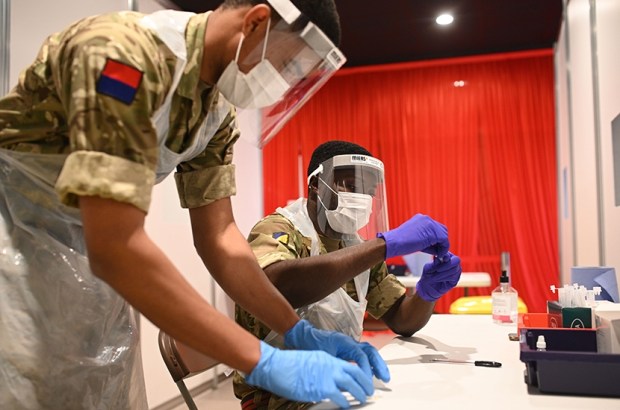The Spanish flu pandemic a century ago resulted in around 50 million deaths worldwide. Its second wave was over ten times more deadly than its first. History is repeating, with the global death toll from Covid-19 this second winter already three times that of the first. In the UK, the number of deaths in this second wave is close to double the number we suffered in the first wave.
The death toll in the first wave, while tragic, is somewhat understandable. A deadly pandemic came out of the blue, and we had to work out the best way of responding. But we cannot use this excuse to explain the higher death toll in our second wave, as we have had months to prepare this time. Of course, part of the reason for the higher death toll is that our second wave is over a full winter, unlike the first waves that started in March in the UK for both Covid-19 and the Spanish flu a century ago. But another reason is that the virus just operates much faster than most of our responses to it.
One way of looking at this difference in speeds is to use an analogy with ‘dog years’. It is often said that a human year is the equivalent to seven ‘dog years’. Covid-19 can deliver the growth and evolution in a year that has taken the human race hundreds of years. A human year might therefore be the equivalent of hundreds of ‘virus years’, as the virus operates hundreds of times faster.
But our difficulties in dealing with the virus are made much worse because our response is dependent on our social-political system — which operates in ‘government years’. ‘Government years’ are much slower than human years because of, for instance, the need to build consensus across departments and political groups, and to ensure decisions are documented robustly in case of a future inquiry.
Around the world, some governments, especially tyrannies, have managed to operate faster; and some confederations, such as the EU, have operated even slower than usual government years. But we also have examples in the UK of breaking out and operating at speed. So, for instance, in England we built the Nightingale hospitals in days, as opposed to the decade that it would normally take. When it came to vaccines, we were able to develop, test, select and pre-purchase hundreds of millions of doses in months rather than years, and administer these at pace. Both of these cases worked because they operated outside our normal government processes: the Nightingale hospitals and vaccine rollout were co-led by the army, and the vaccine effort led by the taskforce, specifically chosen to avoid the cumbersome and therefore painfully slow government procurement processes.
To beat the virus, we have to operate in four particular areas at a speed measured not in government years, but in virus years. First, we need to be faster at addressing vaccine hesitancy or risk a longer lockdown. In 1998 the physician Andrew Wakefield published an article in the Lancet that falsely claimed a link between the measles, mumps and rubella (MMR) vaccine and autism. Publicity around this resulted in a sharp decline in vaccine take-up. Operating at government speed, we took more than ten years to overcome this — in fact, some might argue that take-up of MMR has never fully recovered.
While take-up of the Covid-19 vaccine has been impressively high at 90 per cent for the over-seventies, there are pockets of concern. Nearly half the care homes for older people have more than 30 per cent of staff who are as yet unvaccinated, according to research last week. Black elderly patients say they are 50 per cent less likely to have the vaccine than their white peers. But as our data collection seems to operate at a pace measured in government years, we don’t yet know enough about the demographics of vaccine hesitancy, which does not bode well for a fast response focused on influencing those groups who have not taken the jab.
Second, we need to be much faster at isolating and quarantining. There was much boasting about how the UK has undertaken half the genomic surveillance tests in the world. Yet despite us being able to track the development and spread of the Kent variant, our slow response allowed time for a mass exodus from London and other affected areas, and meant that we let the variant spread across the country and the world.
Similarly, we knew about the South African and Brazilian variants in December. But despite being aware of poor compliance with existing quarantine measures, we opened our compulsory quarantine hotels only this week, more than 50 virus years later. As we vaccinate more, the virus will come under more natural selection pressure to evolve into a vaccine-busting variant. We need to be ready to respond with more border restrictions and internal movement controls similar to those used by the Chinese and Australian authorities around outbreaks. It might not seem very British to issue curfews and install roadblocks around a part of the country within an hour to prevent movement, or to announce overnight that everyone currently on holiday in Spain has to quarantine in a hotel when they return because of a variant of concern. But with an adversary operating in virus years, a response at this speed is required.
Third, we need to be much faster at developing, manufacturing and delivering vaccines so we can respond to new variants. The US target is to be able to design and make 600 million vaccination shots within six months. But even at that speed, we could face another six-month lockdown if a vaccine-defeating variant puts us back to square one. We should consider what it would take to scale-up our processes so that we could design, manufacture and deliver the first dose of a new vaccine to the whole population within three months. It might seem incredible to talk about operating at that speed, but it is technically possible. To get faster still, we should explore developing and stockpiling vaccines for variants that have not yet mutated, by forecasting possible future variants.
Finally, we need to be much faster at innovating around treatments, in both pharmaceutical and clinical practices. As a result of some of the treatment successes to date (such as the drug dexamethasone and the proactive measure of using the prone position), the death rate among those admitted to hospital has roughly halved, according to a Sage paper. Many potential treatments are broad in their coverage and so should provide some protection against vaccine-resistant mutation, while we redesign, re-manufacture and re-administer new vaccines.
But the speed of our innovation of treatments so far can be measured in government years. For instance, the UK’s Recovery-RS trial, sponsored by the National Institute for Health Research, is assessing the efficacy for those hospitalised of different breathing techniques, a vital question for many clinical practitioners. Despite the excellent work by those running the trial, we are still waiting for results because of the time taken to set it up and recruit patients — due to organisational inefficiencies between the NHS, NIHR, Medicines and Healthcare products Regulatory Agency, and Department of Health, and no one in the lead for raising the profile of the trials. Promising drugs which are supposedly being fast-tracked still seem to spend around a hundred virus years moving from their successful phase 2 trials to phase 3 (disclosure: I have invested in some of these).
If we are to operate at a speed measured in virus years, we need to change our approach, in particular around the leadership being deployed and the decision-making process. As Katy Balls has reported for this magazine, the Vaccine Taskforce is being viewed as a model for how the government works in the long term, but more immediately we need to use it as a model for elsewhere in our pandemic response. The Vaccine Taskforce benefited from being Kate Bingham’s first, second and third priority every day, from her business expertise, and from the sponsorship of the Department for Business, Energy and Industrial Strategy.
In comparison, it seems unlikely that the Therapeutics Taskforce (yes, we do have one) sponsored by the Department of Health and Social Care has the same level of priority for its chair, deputy chief medical officer Professor Jonathan Van-Tam, given his other responsibilities. Vaccine Taskforce decisions were made by a small group, but decisions on border quarantining need to involve No. 10, the Foreign Office, the Home Office, the Treasury, the Cabinet Office, as well as the Departments of Transport, and Health and Social Care — hardly the basis of a response measured in virus years.
Throughout the pandemic we have struggled to catch up with the virus. The Kent, Brazilian and South African variants show that the virus can change — but with the Nightingale hospitals and vaccine programme, we have also shown that we can match its speed. If we can apply the same approach to treatments, vaccine development, quarantining and addressing vaccine hesitancy, we might actually catch up with the virus — or even just possibly get ahead of it. And that would change the game completely.
Got something to add? Join the discussion and comment below.
Get 10 issues for just $10
Subscribe to The Spectator Australia today for the next 10 magazine issues, plus full online access, for just $10.
You might disagree with half of it, but you’ll enjoy reading all of it. Try your first month for free, then just $2 a week for the remainder of your first year.














Comments
Don't miss out
Join the conversation with other Spectator Australia readers. Subscribe to leave a comment.
SUBSCRIBEAlready a subscriber? Log in